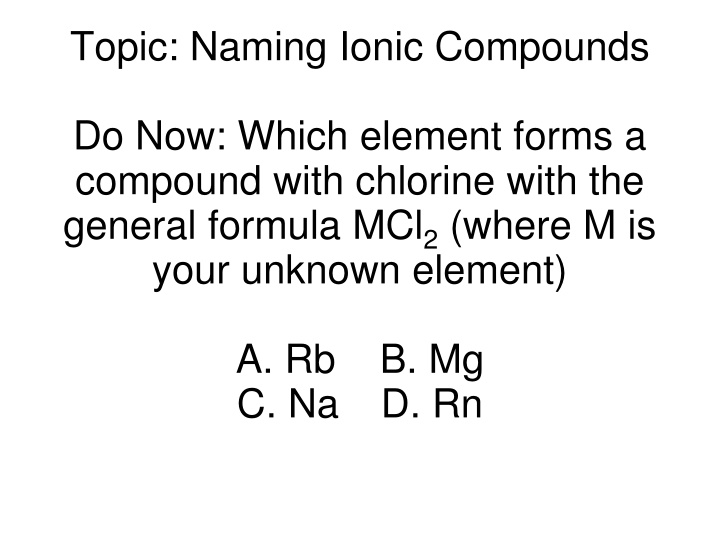
Naming Ionic Compounds & Oxidation States Guide
Learn how to name ionic compounds, determine oxidation states of metals, and use Roman numerals in compound names. Explore a flow chart for easy naming and understanding of binary ionic compounds. Discover the principles behind assigning oxidation states and naming compounds based on their chemical formulas.
Download Presentation

Please find below an Image/Link to download the presentation.
The content on the website is provided AS IS for your information and personal use only. It may not be sold, licensed, or shared on other websites without obtaining consent from the author. If you encounter any issues during the download, it is possible that the publisher has removed the file from their server.
You are allowed to download the files provided on this website for personal or commercial use, subject to the condition that they are used lawfully. All files are the property of their respective owners.
The content on the website is provided AS IS for your information and personal use only. It may not be sold, licensed, or shared on other websites without obtaining consent from the author.
E N D
Presentation Transcript
Topic: Naming Ionic Compounds Do Now: Which element forms a compound with chlorine with the general formula MCl2(where M is your unknown element) A. Rb C. Na B. Mg D. Rn
Naming Binary Ionic Compounds there is a flow chart for you to use in the front of your packet 1. Always name metal (the cation/+ ion) first 2. Leave a space 3. Write stem of nonmetal (the anion/ - ion) and Add ending ide to nonmetal Binary = only 2 types of elements (two capital letters)
Stems of nonmetals Nitr Ox Fluor Phosph Sulf Chlor Arsen Selen Brom Hydr is the stem for H Tellur Iod
Metals with one oxidation state CaO BaS AlN LiCl Al2Se3 Na2O K3N MgF2 Calcium Oxide Barium Sulfide Aluminum Nitride Lithium Chloride Aluminum Selenide Sodium Oxide Potassium Nitride Magnesium Fluoride
The First Step in Naming Find metal on PT If metal has only one oxidation state it s easy If metal has more than one oxidation state, there s an extra step
Metals with more than 1 oxidation state Use formula to figure out which oxidation state metal ion has Ex: Fe can be Fe+2 or Fe+3 FeO vs Fe2O3 two different compounds so cannot both be called iron oxide so we have to use Roman Numeral to Tell which Fe (Fe+2 or Fe+3) we are using Iron (II) Oxide uses Fe+2 Irons (III) Oxide use Fe+3
When deterring Oxidation State of Metal being used, assigned the nonmetal it s oxidation number first (will be the top oxidation number from the PT)
FeO Compounds are electrically neutral Oxygen is -2 1 O which is -2 so Fe must be +2 FeO Name: Iron (II) oxide but means Iron (+2) Oxide (roman numeral II = charge on Fe is +2)
FeO and Fe2O3 Each O is -2 Each Fe is +3 Fe2O3 There are 3 O s 3 X (-2) = -6 Total negative charge Total positive charge must be +6 Name: Iron (III) oxide but means Iron (+3) Oxide (roman numeral III = charge on Fe is +3)
Name the following Titanium (III) chloride TiCl3 MnO2 Co2O3 PdBr2 AuCl3 MoN MnO TiO Manganese (IV) oxide Cobalt (III) oxide Palladium (II) bromide Gold (III) chloride Molybdenum (III) nitride Manganese (II) oxide Titanium (II) oxide
Summary for Binary Ionic Compounds Compounds are electrically neutral Formula: positive first If metal has more than 1 oxidation state, name has roman numeral (MOST ALL TRANSITION METALS need this) Name = metal + stem of nonmetal + ide
Naming compounds with polyatomics polyatomic ions have names (Table E) naming is parallel to binary naming positive always written first if (+) ve ion is a metal, check to see how many oxidation states it has if > 1 then name must have roman numeral if ( ) ve is polyatomic - 2nd part of name is name of polyatomic (don t modify ending)
Name the following Sodium hydroxide Potassium hydrogen carbonate Lithium nitrate Calcium sulfate Aluminum nitrate Iron (II) hydroxide Copper (II) sulfate Copper (I) thiocyanate NaOH KHCO3 LiNO3 CaSO4 Al(NO3)3 Fe(OH)2 CuSO4 CuSCN
